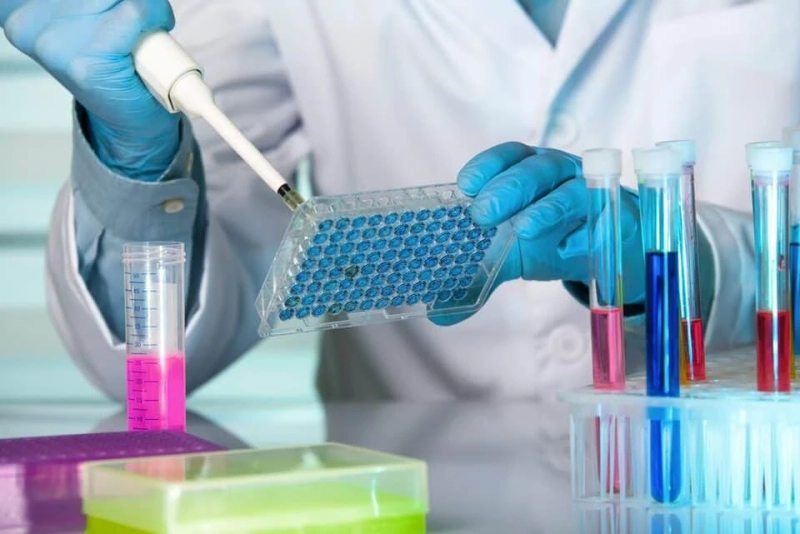What are the Different Types of ELISA Assays?
There are four major kinds of ELISA Assays:
Direct, indirect, sandwich, and competition ELISA Assay.
Three factors mainly influence the type of ELISA assay that you have to choose for your research:
- Kinds of antibodies are available.
- What result/results do you seek
- How complex your sample is.
Direct ELISA
How does it work:
All ELISA assays require multi-well plates. The antigen is first immobilized on a multi-well plate. Then an antibody is introduced into the mix to detect the antigen. The antibody is, in turn, joined to an enzyme like HRP (Horseradish Peroxidase), which is noticeable and hence makes the entire antibody-antigen pairing detectable.
Advantages:
1. It’s faster than all other techniques because it involves fewer steps.
2. Since there are fewer steps involved, there are fewer chances of error. The number of reagents used is also less, so this process is less error-prone.
Disadvantages:
1. This process has a higher number of background disruptions than indirect ELISA since the process of making the antigen immobilized is not specific. These disruptions are caused when not just the target protein but all proteins bind to the multi-well plate.
2. This process has no room for flexibility because a few specific enzyme-conjugated primary antibody is required to target the protein in question.
3. There is no possibility of amplifying the detectable signal produced by the enzyme, so this isn’t a very sensitive assay.
When do we use it:
Direct ELISA Assays are most commonly used to analyze the immune response to a particular antigen.
Indirect ELISA
How does it work:
This technique requires more than one step to immobilize the antigen on a multi-well plate. In the first step, a monoclonal unlabelled antibody is used to bind with the target antigen. Then, a polyclonal secondary antibody that is already conjugated to the detectable enzyme is introduced into the mix to bind to the first antibody-antigen complex.
Advantages:
1. Increased sensitivity because there is more than one secondary antibody available that can bind the first antibody.
2. Most cost-effective because a lesser number of labeled antibodies are required.
3. Way more flexible than the first kind of ELISA assay because here several primary antibodies are available that can bind with the secondary antibody.
Disadvantages:
1. Background disruptions still exist because of the cross-reactivity caused by the secondary antibody.
2. More time-consuming than Direct ELISA because an extra incubation step is needed for the secondary antibody.
When do we use it:
If you want to figure out the total antibody concentration of a sample, you can use this indirect ELISA technique.
Sandwich ELISA
How does it work:
A matched pair of antibodies are required for Sandwich ELISA Assays. These are called the capture and detection antibodies. The two antibodies must detect separate epitopes. First, a polystyrene plate is coated with a capture antibody. Then the sample is added. After this, a detection antibody is presented into the mix. If it is already conjugated with the enzyme, it is called a direct sandwich ELISA. Whereas, if the detection antibody is not conjugated already, another conjugated detection antibody has to be introduced. This process is called indirect sandwich ELISA.
You can use a monoclonal and a polyclonal antibody for this assay but remember to make the polyclonal antibody the capture antibody because it can attract the highest number of target antigens.
Advantages:
1. This method is 2 to 5 times more sensitive than both direct and indirect ELISA.
2. This method also has more specificity since it makes use of two antibodies.
3. More flexible since you can opt for the direct or the indirect method.
Disadvantages:
You have to make sure you’re using a tested pair of antibodies or at least a standardized kit because antibody optimization tends to become difficult in this process.
When do we use it:
If you have a sample too complex from direct or indirect ELISA, go for this method. With Sandwich ELISA, you don’t need to purify the antigen before measurement.
Competition ELISA
How does it work:
Any of the previous methods can be converted into a competition ELISA even though the process is incredibly more complex. If one wants to measure the antibody or antigen concentration of a sample, competition ELISA is used. The core principle behind competition assay is simple enough. The antigen interferes with the signal emitted by the labeled antibody. So, the stronger the signal is, the lesser the concentration of the antigen and vice versa. There is an inversely proportional relationship between the concentration of antibodies and the signal emitted.
Advantages:
1. Any impure sample can be used. There is no requirement of processing the crude sample.
2. This method is less sensitive in the face of sample dilution than sandwich ELISA.
3. Maximum flexibility because all the above methods can be turned into competition ELISA.
Disadvantages:
Some of the characteristic disadvantages of the above methods remain when they are converted into competition ELISA.
When do we use it:
If you are stranded with only one antibody that can pair with a target antigen, this is the only method you can use.
Conclusion
Now that you have an idea of how the four kinds of ELISA work, you have to choose which method works out the best for you based on the three factors mentioned right at the beginning of the article.



